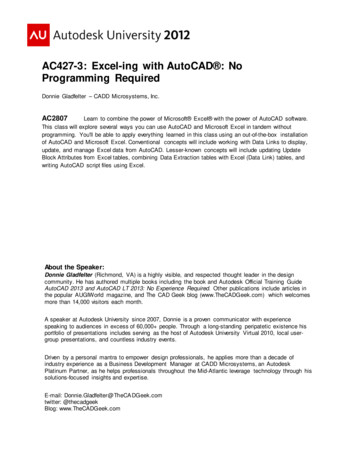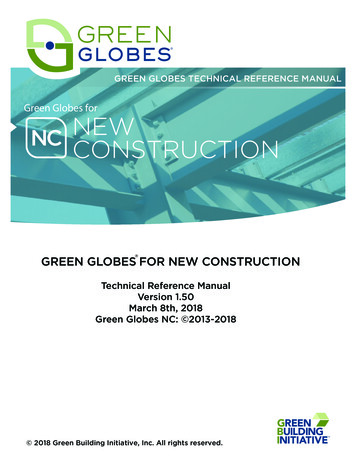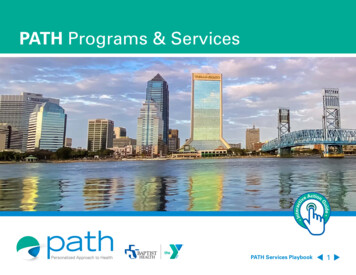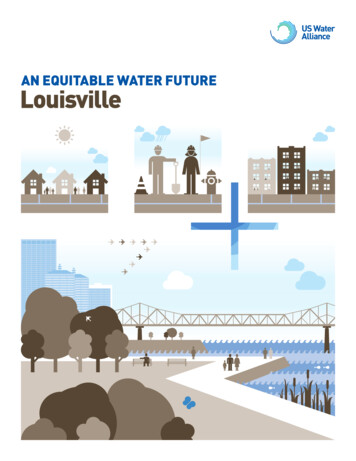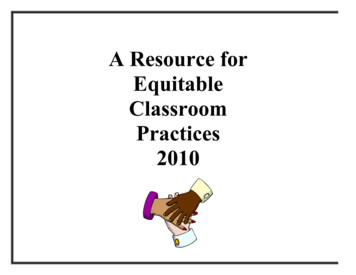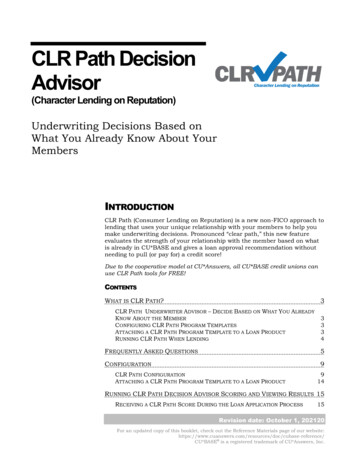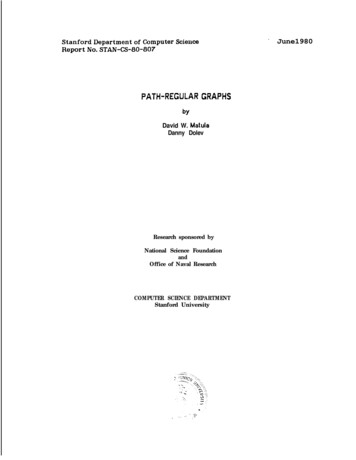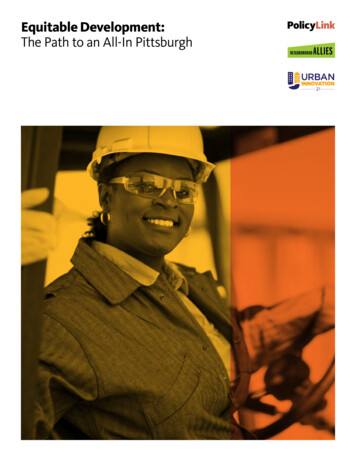
Transcription
Equitable Development:The Path to an All-In Pittsburgh
AcknowledgmentsMany thanks to the core project team for their hard workand valuable contributions to this report, including PresleyGillespie, Shad Henderson, and Doni Crawford of Neighbor hood Allies; Bill Generett, Marteen Garay, and James Myersof Urban Innovation21; Jamil Bey and Tayler Clemm of theUrbanKind Institute; and Angela Glover Blackwell, Rosa Carrillo,Shaibya Dalal, Heather Tamir, and Chris Schildt of PolicyLink.The entire team is grateful to the more than 200 local leaderswho supported and informed this report by participating ininterviews or attending workshops to help us craft the defi nition of equitable development and shape our recommen dations. We thank The Heinz Endowments for supporting thiswork and promoting the vision of a Just Pittsburgh, and wethank the national funders of our All-In Cities initiative:Prudential, the Surdna Foundation, and the JPMorgan ChaseFoundation. We also thank Mayor William Peduto and hisstaff including Kevin Acklin, Kyle Chintalapalli, Grant Ervin,and LaTrenda Sherrill, and former staff member Betty Cruz,for their support of this project, including helping us conveneroundtables with local developers and organizations workingwith the Latino, immigrant, and refugee communities throughthe Welcoming Pittsburgh effort. 2016 PolicyLink. All rights reserved.PolicyLink is a national research and action institute advancingeconomic and social equity by Lifting Up What Works .Through the All-In Cities initiative, we equip city leaderswith policy ideas, data, and strategy to make racial economicinclusion and equitable growth their reality.www.policylink.orgNeighborhood Allies supports the people, organizations andpartnerships committed to creating and maintaining ban Innovation21 is a public-private partnership workingto drive economic growth that is inclusive and equitable.www.urbaninnovation21.orgEquitable Development: The Path to an All-In Pittsburgh2
Equitable Development:The Path to an All-In PittsburghSarah TreuhaftEquitable Development: The Path to an All-In Pittsburgh1
Contents3Introduction6Why Pittsburgh Needs Equitable Development Now891422An Equitable Development Agenda for PittsburghI. Raise the Bar for New DevelopmentII. Make All Neighborhoods Healthy Communitiesof OpportunityIII. Expand Employment and Business OwnershipOpportunitiesIV. Embed Racial Equity Throughout Pittsburgh’sInstitutions and BusinessesV. Build Community Power, Voice, and Capacity25Conclusion26Notes1820Equitable Development: The Path to an All-In Pittsburgh2
IntroductionPittsburgh is a city on the rise. After decades of declinefollowing the collapse of the steel industry, the region hassuccessfully transformed its manufacturing economy into onedriven by knowledge and technology. Young college graduatesare moving in and a thriving start-up and entrepreneurialculture has taken root. A development boom is also underway,with some 8,000 new market-rate homes coming online notonly downtown, but also in neighborhoods like East Liberty,Lawrenceville, and Uptown.1This resurgence brings great potential to deliver long-awaitedjobs, economic opportunities, and neighborhood improve ments to the region’s low-income communities and commu nities of color. Yet locally, the pervasive sense is that thereare “two Pittsburghs”: one growing more prosperous, and theother cut off from opportunity by poverty, structural racism,and discrimination. The data show this fear is well-justified:over the past five years, racial gaps in wages, employment,and poverty have widened rather than narrowed, rankingPittsburgh 78th among the largest 100 regions when it comesto progress on racial economic inclusion according to aBrookings Institution analysis.2 Numerous reports—includingtwo released last year by the Urban Institute and the Universityof Pittsburgh Center on Race and Social Problems—documentPittsburgh’s stark and persistent racial inequities, particularlyfor its Black residents, in income, employment, education,health, wealth, housing, and opportunity.3 Data in the NationalEquity Atlas show that racial inequality has a steep cost:Pittsburgh’s economic output would be about 5 billion higherevery year absent its racial inequities in income.4Pittsburgh’s comeback is also geographically uneven. Acrossthe city’s 90 neighborhoods, some are gentrifying, with risingrents and home prices threatening longtime residents andbusinesses with displacement. The horror of mass displace ment came true in June 2015, when the owner of Penn Plazaapart ments in East Liberty sent notices to vacate to about200 tenants, many of whom were low-income, elderly, andBlack. And a Washington Post analysis of home-price increasessince 2004 found the zip code containing Lawrenceville andGarfield has some of the highest increases nationwide.5 Atthe same time, many more Pittsburghers live in neighbor hoodsthat continue to lose population, are dotted with vacant lots,and suffer from a lack of new investment and private marketactivity. Other working-class families, priced out of up-andcoming neighborhoods or searching for better schools andsafer streets, are moving to older suburbs like Penn Hills—often arriving in communities facing decline that lack adequatepublic transportation, services, and other key ingredientsof economic success.Equitable Development: The Path to an All-In Pittsburgh3
In the face of these trends, urgent action is needed to steergrowth and change in a new direction: toward one, “all-in”Pittsburgh. The evidence is clear that the benefits of newgrowth and development will not automatically trickle down topoor and working-class residents. Local leaders must imple ment a targeted, intentional strategy to ensure all can thrive inthe new Pittsburgh. That strategy is equitable development.As a part of the process for developing this report, PolicyLink,Neighborhood Allies, and Urban Innovation21 conveneddozens of Pittsburgh community leaders to create a shareddefinition of equitable develop ment, and this is how wedefined it:Equitable development is a positive development strategythat ensures everyone participates in and benefits fromthe region’s economic transformation—especially lowincome residents, communities of color, immigrants, andothers at risk of being left behind. It requires an intentionalfocus on elimin ating racial inequities and barriers, andmaking accountable and catalytic invest ments to assurethat lower-wealth residents: live in healthy, safe, opportunity-rich neighborhoods thatreflect their culture (and are not displaced from them); connect to economic and ownership opportunities; and have voice and influence in the decisions that shapetheir neighborhoods.Realizing this vision of equitable development is no small task.Cities across the globe have struggled to develop in ways thatensure their long-standing residents benefit from change, andPittsburgh is no exception. The region’s inequities have deeproots, and eliminating them will require healing wounds thatare still gaping, including the legacies of urban renewal andredlining. In 1956, to build the Civic Arena for the PittsburghPenguins hockey team, the city demolished 1,300 buildings,evicting more than 400 businesses and 8,000 people (includingmore than 1,000 Black families) in the Lower Hill District.6The domed arena came down in 2011, and a mixed-use, mixedincome development is now planned for the 28-acre site,which is currently a parking lot. But, for many, it remains apainful reminder of government actions that harmed theBlack community.Yet, Pittsburgh is in an ideal position to make equitabledev elop ment its new reality. The region’s rebound from thebrink of economic collapse is a testament to its ability totake on the toughest challenges and not just imagine butactually build a different future. Just as community, govern ment, philan thropic, and business leaders laid the ground work for today’s resurgence, they now need to take on theEquitable Development: The Path to an All-In Pittsburghchallenge of equitable growth with the same gusto, unlockingoppor tunities and tapping the ingenuity and creativity of itsresidents to build a stronger, more resilient, more inclusiveregion for all. Many are already taking up the challenge, andemerging models of equitable development can be foundacross the region. On the Northside, a group of tenants came together asthe Northside Coalition for Fair Housing to first preventthe eviction of more than 300 families, and then securedfunding from the city to buy a majority share of thedevelopment, creating a unique tenant ownership modelthat has guaranteed affordability and improved the livingconditions and livelihoods of hundreds of tenants.7 In Homewood, the 100,000-square-foot formerWestinghouse factory, redeveloped by Bridgeway Capital,has been transformed into a business incubator, with 85percent of the construction contracts going to minorityowned businesses. The main contractor, Ma’at ConstructionGroup, hired and trained young apprentices who facebarriers to employment, such as criminal records, onthe project.8 In Larimer, a community-driven planning process is nowguiding the redevelopment of the long-distressedneighborhood and two public housing complexes into amixed-income community.Building on Local KnowledgeThe definition of equitable development shared herebuilds on local ideas and advocacy. A report on equitabledevel opment released in January 2016, Black HomesMatter: Alternate Approaches to Neighborhood Revitali zation in the City of Pittsburgh, produced by the PittsburghFair Development Action Group, shared the followingprinciples for equitable development. Do no harm to residents and small business ownersIncrease access to opportunityIncrease resident incomesSupport resident ownership of housingSupport resident ownership of businessesEnsure long-term housing securityOur definition and recommendations endorse and seekto advance these principles.4
This report—based on interviews and conversations withdozens of Pittsburgh leaders and drawing from national bestpractices and approaches to equitable development—under scores the urgency of equitable development for Pittsburghand outlines a five-point agenda to achieve it, with 16 specificrecommendations.I. Raise the bar for new development. As the regionundergoes a development boom, new development andgrowth must happen in a way that benefits and doesnot displace longtime lower-income residents and neigh bor hood entrepreneurs.II. Make all neighborhoods healthy communities ofopportunity. Beyond new development, the region needsa comprehensive strategy to increase housing affordabilityand stability and to unlock opportunity in its highestpoverty neighborhoods.Implementing this agenda and setting Pittsburgh on the pathtoward truly shared prosperity will take courage, hard work,and investment. A group of core equity leaders have beenmeeting regularly for the past year to develop strategies andinform this report. For equitable development to happen,this informal strategizing needs greater structure to advancecollective goals. At the same time, leaders working throughoutthe region’s public, private, and nonprofit sectors need toassume the mantle of inclusion and commit to moving beyondtalk to deliver results for those who are being left behind. Mostimportantly, Pittsburgh must do the difficult and uncomfortablework of confronting structural racism and bias with dialogueand action, unleashing the potential of all Pittsburghers andthe region as a whole.III. Expand employment and ownership opportunities.Connecting lower-wealth residents to good, familysustaining jobs and asset-building opportunities is criticalto ensuring they participate in and contribute to theregion’s resurgence.IV. Embed racial equity throughout Pittsburgh’sinstitutions and businesses. To eliminate wide racialinequities and uproot bias, the region’s institutions,organizations, and businesses need to adopt racial equityfocused approaches.V. Build community power, voice, and capacity. Highcapacity community-rooted organizations and multiracial,multisector coalitions are essential to advancing equitabledevelopment policies and practices over the long term.Up the street from this mural, a vacant linen warehouse isbeing renovated into the Bloomfield neighborhood’s firstcondo development. (William Real/Flickr)This agenda represents a core set of strategies that we viewas catalytic and meaningful starting points for making realprogress toward equitable development in Pittsburgh at thismoment. While it is wide-reaching, this agenda is not com pre hensive. To truly maximize equitable development, itsprinciples must be expressed in every policy arena, includingtransportation, criminal justice, public education, health,workforce development, food systems, immigrant integration,and more. And given that the majority of the region’s poorpopulation lives outside of the city of Pittsburgh, a regionalapproach is needed.Equitable Development: The Path to an All-In Pittsburgh5
Why Pittsburgh NeedsEquitable DevelopmentNowEquitable Development: The Path to an All-In Pittsburgh6
Pittsburgh’s racial, economic, and geographic inequities arenot only a moral challenge, but also a threat to its long-termresilience and prosperity. The region cannot reach its fullpotential while so many of its residents, and a growing segmentof its workforce, face barriers to participating and contributingas consumers, workers, entrepreneurs, innovators, and leaders.One of the key themes from interviews with local leadersand decision makers interviewed for this project was thatracial bias—at the individual and institutional levels—is a keychallenge to progress in the region. They expressed howbridging racial gaps is an economic imperative in addition toa moral one. Recent research also underscores how greaterequity and inclusion are critical to solving the region’s biggestchallenges and building a robust, resilient economy.Cultivating homegrown talent is central to solving theregion’s workforce challenge. The Allegheny Conference onCommunity Development’s recent Inflection Point study onthe region’s workforce needs revealed that Pittsburgh couldface a shortfall of 80,000 workers over the next decade asbaby boomers retire and employers demand ever higher levelsof skills. Every year, 29,000 baby boomers will leave theworkforce and another 5,000 new jobs will be created, yet thereare not enough new workers with the skills to fill these jobs.The report cited the need to attract new young workers andretain university students to meet the region’s workforceneeds. It also noted the importance of preparing Pittsburgh’syoung people who are entering the workforce as well asits unemployed and underemployed residents for these jobopenings. In the region, 32,000 long-term residents areunemployed, many of whom could be trained to fill middleskill jobs that require some training but not a four-yearcollege degree.9Greater inclusion will help the region attract and retaindiverse workers. While Pittsburgh needs to attract and retainnew workers, its lack of diversity and racial inequities hinderit from doing so. Pittsburgh is becoming more diverse overtime, but it is much more homogeneous than its peers and isthe least diverse of all 40 regions with populations over onemillion; people of color represent just 13 percent of residentsin the region (although 35 percent of city residents are ofcolor).10 Many people of color and immigrants do not feelwelcome to the area. The 2016 Pittsburgh Regional DiversitySurvey found that while 79 percent of White Pittsburghersthink the region is welcoming to people of color, only 36percent of residents of color and 46 percent of foreign-bornresidents report feeling welcomed in the region.11 Millennials—specifically, workers ages 25 to 34—are coming (or staying)Equitable Development: The Path to an All-In Pittsburghto work in Pittsburgh’s technology and innovation industries,but the lack of diversity could hinder the region’s ability toretain them.12Ensuring Pittsburgh’s low-income residents can stay in ormove to opportunity-rich neighborhoods is an antidoteto intergenerational poverty. Equitable development wouldresult in more low-income children of color living in neighbor hoods that are improving or already thriving, which researchshows would provide them with a much better chance ofescaping poverty, attaining good health, and moving up theeconomic ladder. Economist Raj Chetty’s research on economicmobility finds that place plays a key role in increasing theodds that children born poor will move up the economic ladder:neighborhoods with less racial and economic segregation,less income inequality, better primary schools, greater socialcapital, shorter commutes, and more family stability providegreater upward mobility.13 While the effects of displacementare notoriously difficult to study, a recent study by the FederalReserve Bank of Philadelphia found that when lower-incomeresidents move out of gentrifying neighborhoods they moveto areas with lower-performing schools and a lower qualityof life. On the other hand, when they stay in neighborhoodsthat are improving, they improve their financial conditions.14Racial diversity, local art and culture, and thriving residentowned businesses are key assets of Pittsburgh’s up-andcoming neighborhoods. Rising rents and home prices ingentrifying neighborhoods threaten to push out lower-incomeresidents of color along with their culture and small businesses,yet it is the very presence of diverse neighbors, culturalexpressions, and businesses that makes these neighborhoodsattractive to newcomers. As developer Tony Dolan, who hasbuilt many of the new luxury apartments in East Liberty andelsewhere put it: “The millennials moving into my apartmentbuildings don’t want to live in sanitized neighborhoods.”15Negotiating neighborhood change and fostering authenticrelationships and connections between new and longtimeresidents from very different backgrounds is always challeng ing. But in a city like Pittsburgh that has suffered from longterm depopulation and has plenty of developable land, thereis space for everyone. Ensuring that longtime residents andbusiness owners have the resources and opportunities to stay,thrive, and connect is a winning proposition for residents,developers, newcomers, and the city as a whole.7
An EquitableDevelopment Agendafor PittsburghTo address these challenges and put the region on the pathto equitable development, Pittsburgh’s leaders in the public,private, philanthropic, and nonprofit sectors need to ensurenew development projects deliver on the vision of equitabledevelopment while advancing the broader, transformationalchange needed to link low-wealth residents to economicand neighborhood opportunities. We propose the followingfive-point agenda and specific recommendations for equi tabledevelopment.I. Raise the bar for new development.1. Set equitable development goals, performancemetrics, and a reporting framework.2. Require publicly supported projects to advance equi table development.3. Ensure accountability through monitoring andenforcement.II. Make all neighborhoods healthy communities ofopportunity.4. Implement the city’s Affordable Housing Task Forcerecommendations.5. Track and monitor neighborhood opportunity andchange to continuously inform policy strategies.6. Develop a community land trust strategy.7. Use publicly owned land for equitable development.8. Invest in resident-driven art, culture, and enterprise.9. Support community schools, neighborhood safety,and justice.III. Expand employment and ownership opportunities.10. Implement targeted racial equity strategies as part ofthe Inclusive Innovation Roadmap.11. Leverage anchor institution spending to supportinclusive business development.IV. Embed racial equity throughout Pittsburgh’s institutionsand businesses.12. Adopt a racial equity focus within govern ment.13. Advance equity, diversity, and inclusion in the businesscommunity.V. Build community power, voice, and capacity.14. Support multiracial, cross-sector collective action forequitable development.15. Ensure sustainable funding for neighborhood-basedorganizations and development strategies.16. Fund tenant organizing and resident leadershipdevelopment.Equitable Development: The Path to an All-In Pittsburgh8
I. Raise the Bar for NewDevelopmentIt is time to raise the standards for all new developmentprojects in Pittsburgh, especially those that are supported bygovernment actions and investments. After decades of effortsby Pittsburgh’s government, community development sector,and residents to shore up distressed neighborhoods andattract private investment, the real estate market has changed.Pittsburgh needs to modernize its land-use developmentpolicy framework and tools to keep up with these changesand leverage market forces in order to address racial inequitiesand build a stronger and more inclusive region.Across the country, communities are demanding greateraccountability and tangible benefits from projects built byprivate developers with public subsidies in the form of“community benefits agreements” or CBAs. Broad community,labor, and environmental coalitions have negotiated bindingCBAs that ensure large development projects provide livingwage jobs, affordable homes, business opportunities, neigh borhood amenities, and other benefits. In Pittsburgh, the OneHill CBA Coalition secured a CBA for the redev elopment ofthe Civic Arena into the Consol Energy Center in 2008; thisCBA included funding for a community master plan, supportfor the much-needed Shop n’ Save grocery store, living wages,local hiring, and more.16 A second agreement focusing onthe remaining 28-acre site of the former arena was signedin 2014.17New development projects create opportunities to connectresidents facing barriers to employment to good jobs andcareer pathways. (Talia Piazza/Neighborhood Allies)Equitable Development: The Path to an All-In PittsburghAs the CBA movement has matured, communities have soughtto make community benefits more of a standard practice.Many cities have passed policies that require specific commu nity benefits (such as living wages or local hiring) frompublicly supported development projects. While individuallynegotiated CBAs can meet specific community needs andhelp to build the power of community coalitions, negotiatingproject-by-project agreements is a time-consuming endeavor.Citywide policies can have a broader impact by providingdevelopers with clear expecta tions and predictable costs whilenot requiring individual negotiations.9
To raise the floor on new development, Pittsburgh leadersshould pursue a threefold strategy: 1) support inclusivecommunity-driven efforts to negotiate CBAs on very largeprojects; 2) adopt a set of baseline community benefitsexpectations for development projects, with requirementsfor those receiving public support (see text box below);and 3) establish a “race-to-the-top” system of performancemetrics that incentivizes developers to provide additionalcommunity benefits beyond baseline requirements. To theextent possible, these commu nity benefits expectations andthe performance metrics should apply to private employersseeking economic development subsidies in addition todevelopers. They should apply to public works projects andinfrastructure investments as well, such as the 2 billionsewer upgrade currently in the works.Community Benefits ExpectationsBaseline community benefits expectations shouldinclude the following goals. Local and targeted hiring of residents and disadvantagedworkers, in both construction and ongoing operationsat a project Job training, including access to apprenticeships Creation of high-quality construction and permanentjobs that provide living wages, career pathways, and fairschedules and work environments Contracting opportunities for small local-, minority-,and women-owned businesses Affordable homes for low-income households, includingfamily-sized units, with long-term affordability covenantsto preserve affordability over time Affordable rents for small local-, minority-, and womenowned businesses, with long-term rent stability Labor peace agreements providing workers the rightto organize One-for-one replacement of affordable homes “Build first” before demolishing so tenants can moveinto new units with minimum disruption Relocation assistance for displaced tenants Right to return for displaced tenants Energy-efficient building techniques Resident and small business-owner engagement in thedevelopment and planning processEquitable Development: The Path to an All-In Pittsburgh1. Set equitable development goals,performance metrics, and a reportingframework.Pittsburgh’s economic development leaders need to use theirpower and influence to set high expectations from all devel opment projects and employers, including those that do notuse public subsidies. The city should lead the way by officiallyadopting equitable development goals and perfor mancemetrics, and by producing guidelines that define expectations,explain current requirements and aspirational targets, andprovide examples of successful implementation from Pittsburghand elsewhere. Ideally, these goals and performance metricswould be a part of a broader strategic plan and vision forequitable economic growth that includes citywide goals andperformance measures, such as Portland’s economic devel opment agency has done.18Developers and employers should be asked to submitCommunity Impact Reports that outline how they will meetthese expectations, provide data for the performancemetrics, and assess the impacts of the project and potentialdisplacement or other risks for low-income and marginalizedcommunities. These reports should be made publiclyavailable. Equitable development goals and standards shouldalso be integrated into planning and land-use policies,including the city’s comprehensive plan if it moves forward.Community Impact Reports submitted by developers andbusinesses—indicating how proposed projects will impede oradvance the community’s equitable development goals—should be taken into account in awarding subsidies and indiscretionary land-use decisions (including height or densitybonuses). A system of performance metrics is currently beingdeveloped by the p4 (People, Planet, Place, and Performance)initiative spearheaded by The Heinz Endowments and thecity of Pittsburgh. The community benefits described aboveshould be incorporated into that performance metricssystem, and data should be collected on race/ethnicity as wellas income to evaluate how development is fostering racialand economic inclusion.10
Equitable Development in Action:AustinThe city of Austin, Texas, uses a performance-basedapproach to its economic development incentives forbusiness recruitment and expansion. Companies request ing subsidies must meet a set of minimum thresholds(living wages and the provision of health benefits, forexample), and are then scored according to how wellthey meet additional criteria, such as hiring economicallydisadvantaged workers, contracting with disadvantagedbusinesses, and recruiting and training of ex-offenders,as well as fiscal impact.192. R equire publicly supported projects toadvance equitable development.Like most cities, Pittsburgh’s local authorities provide economicdevelopment incentives to private developers in the form oftax abatements, tax-increment financing, public land, and grantfunds, as well as support projects through infrastructureimprovements and in numerous other ways. While the city ofPittsburgh, like all jurisdictions, faces legal limitations on themechanisms it can use to regulate private businesses, it hasgreater leeway in negotiations related to public subsidies, taxincentives, land sales, density bonuses, and so forth. Whenoffering up public funds and proactive support to developers,cities can negotiate from a position of strength, setting highstandards to ensure that their spending delivers on criticalcommunity goals. Specific actions that can advance equitabledevelopment include the following. Implement and fund local and targeted hiring.Development projects create opportunities to addressthe employment challenges of un- and underemployedresidents by providing equitable access to the constructionand permanent jobs created by the development. In citiesacross the country, local and targeted hiring policies havehelped residents and families escape poverty and reacheconomic security.Equitable Development: The Path to an All-In PittsburghSince 1999, Pittsburgh has had a “Pittsburgh Works!” policyon the books that directs at least 35 percent of work hourson city-funded construction projects to city residents, butthis policy has not yet been implemented.20 An updatedpolicy was proposed in 2014 with additional requirementsthat 15 percent of work hours be performed by disadvan taged workers (those with incomes less than half the areamedian or those facing other barriers to employmentsuch as involvement in the criminal justice system), that 50percent of apprenticeship hours go to city residents and25 percent to disadvantaged workers, and that First SourceHiring Centers be established to connect residents totraining and employment opportunities.The city of Pittsburgh should identify a funding sourcefor the First Source Hiring Centers and pass this updatedlegislation, and Allegheny County should establish asimilar policy for the infrastructure and economic develop ment projects it supports, requiring local hiring in bothconstruction and operation of city- and county-supporteddevelopment projects. The city and county should alsoextend these hiring practices to state-funded and federallyfunded projects whenever permissible.21 Strengthen and enforce job quali
Connecting lower-wealth residents to good, family-sustaining jobs and asset-building opportunities is critical to ensuring they participate in and contribute to the region's resurgence. IV. Embed racial equity throughout Pittsburgh's institutions and businesses. To eliminate wide racial inequities and uproot bias, the region's institutions,



